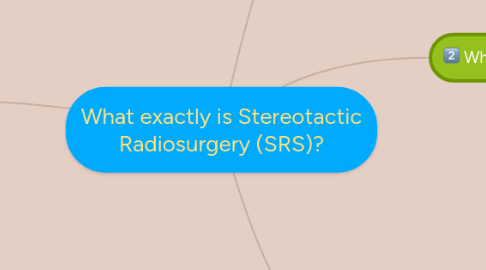
1. Pros and cons considered in using SRS as treatment...
1.1. PROS: No healing time or incisions. Can quickly control tumors to allow time to treat the primary cancer site (Brain mets). Can be repeated over, and in patients who have already undergone conventional whole brain radiation or received maximum radiation dose. Precise, minimizes effects to normal healthy tissues. Only followup is occasional imaging scans to check tumor status. Outpatient procedure. Only discomfort is from the head frame, with possible headache after. Can treat multiple small tumors in one session or sitting. Minimal risk of infection at pin site, shorter recovery than invasive surgery.
1.2. CONS: Swelling possible due to the cells of irradiated tumors losing the ability to regualte fluids, treated with a course of steroids. Necrosis is the tumor tissue that remains, "dies off" and typically shrinks. On rare occasions it can cause problems and require a procedure for removal or debulking. Radiation overdose is possible due to inadequate safeguards in equipment retrofitted for SRS.
1.2.1. IMMEDIATE POSSIBLE SIDE EFFECTS FROM SRS INCLUDE: Nausea and vomiting, temporary hair loss in the area of treatment (radiated area), headache, soreness from headframe (especially at pin site), increased intracranial pressure, orthostatic hypotension, seizure, edema/swelling, necrosis, neural tissue injury (these may occur during or immediately after treatment and are typically gone within a few weeks).
2. What SRS is...
2.1. First developed in 1949 by Swedish neurosurgeon, Lars Leksell to treat small targets (tumors) in the brain that were not amenable to conventional surgery.
2.1.1. SRS has been used in the United States since the mid 1980's.
2.2. Stereotactic Radiosurgery, hereafter referred to as SRS being much improved since basically uses high-dose radiation to be delivered to a small, localized area of the brain and in some cases the spinal cord. This method is used to kill tumor cells by slowing or stopping the tumor growth.
3. What SRS is used for...
3.1. SRS is used for the treatment of brain tumors and some spinal cord tumors.
3.1.1. A brain tumor is defined as a cancerous (malignant) or noncancerous (benign) mass or growth of abnormal cells in the brain.
3.1.2. SRS can be used alone as a singular treatment or in conjunction with invasive surgery and/or conventional radiation therapy as a "boost" or supplement.
3.1.2.1. SRS can be used post-surgical to clear out residual tumor cells.
3.1.2.2. SRS can be used post-conventional whole brain radiation therapy to treat new tumors or to retreat an existing tumor (a person can only ever receive 1 course of conventional whole brain radiation therapy,however SRS can be repeated due to its precision by avoiding previously irradiated areas).
3.1.2.3. Used alone to treat tumors that are inaccessible by invasive surgery, on patients who are not surgical candidates based on health status, and on patients who do not want to undergo invasive surgery and recovery.
4. How SRS works...
4.1. Like conventional radiation, SRS does not remove the tumor or lesion but it changes the DNA of the tumor cells. These cells lose their ability to reproduce and in turn "shrink". The tumor shrinks at approximately the same rate it would grow. Benign tumors and vessel clusters (AVM/AVF) which are typically slow growing take around 18-24 months, while malignant and metastatic tumors which are fast growing can show changes in as fast as a few months time.
4.1.1. The SRS treatment team normally consists of a neurosurgeon, a radiation oncologist, radiation therapist, medical radiation physicist/dosimetrist, biomedical engineer, and a computer programmer.
4.1.2. There are 3 basic forms or types of SRS:
4.1.2.1. Particle Beam/Proton which is very expensive and there are not many in the US. A positive is that this form can be used also to treat other types of cancers throughout the body. Very little research has been able to be done of this mode of SRS.
4.1.2.2. Cobalt-60 based/Photon which is very good for treating tumors less than 3.5cm. A popular brand name synonymous with this type is the GammaKnife.
4.1.2.3. Linear Accelerator based/Linac which is very good for treating tumors even larger than 3.5cm and can also be used on parts of the body other than just the head and neck. The popular brand names synonymous with this type is the Linac Scalpel, CyberKnife, and Novalis. Coincidentally, the LinacScalpel was developed and patented by the University of Florida/Department of Neurosurgery, this mechanical system improves accurate delivery of radiosurgery treatment as well as dedicated computed dosimetry programs. This made it one of the most popular commercial radiosurgery systems worldwide.
4.1.3. A typical SRS treatment only takes around 15 minutes to 2 hours. Including a head frame placement put in place with pins (this keeps your head completely still during the treatment), imaging of the tumor location, computerized dose planning, and radiation delivery.
